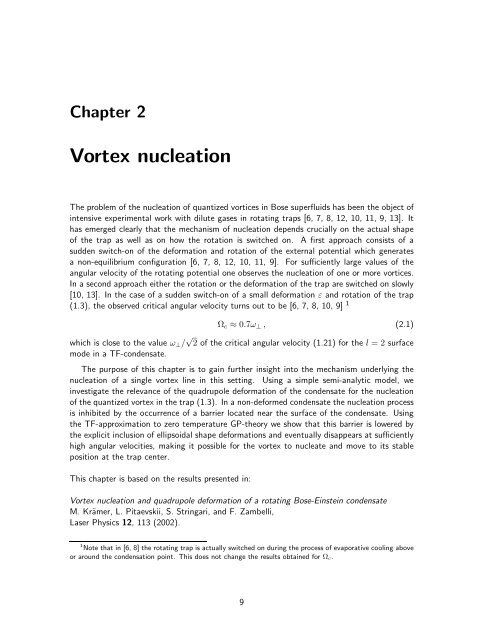Bose-Einstein Condensates in Rotating Traps and Optical ... - BEC
Bose-Einstein Condensates in Rotating Traps and Optical ... - BEC
Bose-Einstein Condensates in Rotating Traps and Optical ... - BEC
Create successful ePaper yourself
Turn your PDF publications into a flip-book with our unique Google optimized e-Paper software.
Chapter 2<br />
Vortex nucleation<br />
The problem of the nucleation of quantized vortices <strong>in</strong> <strong>Bose</strong> superfluids has been the object of<br />
<strong>in</strong>tensive experimental work with dilute gases <strong>in</strong> rotat<strong>in</strong>g traps [6, 7, 8, 12, 10, 11, 9, 13]. It<br />
has emerged clearly that the mechanism of nucleation depends crucially on the actual shape<br />
of the trap as well as on how the rotation is switched on. A first approach consists of a<br />
sudden switch-on of the deformation <strong>and</strong> rotation of the external potential which generates<br />
a non-equilibrium configuration [6, 7, 8, 12, 10, 11, 9]. For sufficiently large values of the<br />
angular velocity of the rotat<strong>in</strong>g potential one observes the nucleation of one or more vortices.<br />
In a second approach either the rotation or the deformation of the trap are switched on slowly<br />
[10, 13]. In the case of a sudden switch-on of a small deformation ε <strong>and</strong> rotation of the trap<br />
(1.3), the observed critical angular velocity turns out to be [6, 7, 8, 10, 9] 1<br />
Ωc ≈ 0.7ω⊥ , (2.1)<br />
which is close to the value ω⊥/ √ 2 of the critical angular velocity (1.21) for the l =2surface<br />
mode <strong>in</strong> a TF-condensate.<br />
The purpose of this chapter is to ga<strong>in</strong> further <strong>in</strong>sight <strong>in</strong>to the mechanism underly<strong>in</strong>g the<br />
nucleation of a s<strong>in</strong>gle vortex l<strong>in</strong>e <strong>in</strong> this sett<strong>in</strong>g. Us<strong>in</strong>g a simple semi-analytic model, we<br />
<strong>in</strong>vestigate the relevance of the quadrupole deformation of the condensate for the nucleation<br />
of the quantized vortex <strong>in</strong> the trap (1.3). In a non-deformed condensate the nucleation process<br />
is <strong>in</strong>hibited by the occurrence of a barrier located near the surface of the condensate. Us<strong>in</strong>g<br />
the TF-approximation to zero temperature GP-theory we show that this barrier is lowered by<br />
the explicit <strong>in</strong>clusion of ellipsoidal shape deformations <strong>and</strong> eventually disappears at sufficiently<br />
high angular velocities, mak<strong>in</strong>g it possible for the vortex to nucleate <strong>and</strong> move to its stable<br />
position at the trap center.<br />
This chapter is based on the results presented <strong>in</strong>:<br />
Vortex nucleation <strong>and</strong> quadrupole deformation of a rotat<strong>in</strong>g <strong>Bose</strong>-<strong>E<strong>in</strong>ste<strong>in</strong></strong> condensate<br />
M. Krämer, L. Pitaevskii, S. Str<strong>in</strong>gari, <strong>and</strong> F. Zambelli,<br />
Laser Physics 12, 113 (2002).<br />
1 Note that <strong>in</strong> [6, 8] the rotat<strong>in</strong>g trap is actually switched on dur<strong>in</strong>g the process of evaporative cool<strong>in</strong>g above<br />
or around the condensation po<strong>in</strong>t. This does not change the results obta<strong>in</strong>ed for Ωc.<br />
9




